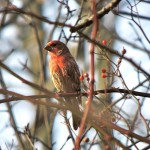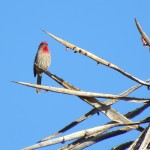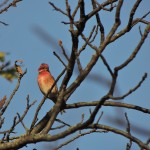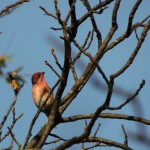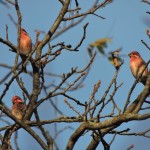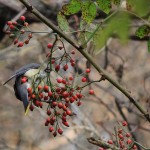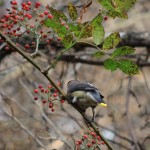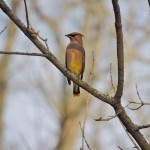28 October 2014. Cayuga ON. For a long time this morning, doing the census round at the bird observatory was like walking into a theatre which, save for a few stragglers, held nothing but empty seats. Where, metaphorical moments ago, there was life, today our rich woodlands and river valley seemed deserted; not entirely of course, but what a contrast to those busy fall migration days of just a few short days and weeks ago.
I was counting American Crows, Red-winged Blackbirds and Blue Jays in ones and twos. I could hear a Carolina Wren on the other side of the river, and an Eastern Bluebird somewhere not too far away but I couldn’t see either of them.
Things looked up when a group of six Purple Finches flew up into the lower branches of a Black Walnut and obligingly sat around to be photographed. Purple Finches are neither common nor uncommon, but they always seem to be noteworthy because the males are so striking. Field guides often describe them as looking as though they’ve been dipped in raspberry juice, a little over-folksy I think, but not inaccurate. It’s quite easy to confuse them with House Finches, but the males of the latter species, while quite surprisingly crimson at times, are not as expansively tinted from head to tail. To illustrate, I have included a couple of House Finches along with some of today’s birds in the gallery below. (Visible only on the website, not if you’re reading this as an email.)
Later, I found a small group of Cedar Waxwings feeding on the bright orange fruits of Multiflora Rose briers. My presence made them flighty, so I sat down and remained quite still. After a while they seemed to accept that I presented no mortal threat and I was able to get the photos below (Also visible only on the website, not if you’re reading this as an email.); and in those same quiet moments caught sight of a Golden-crowned Kinglet.
I was quite pleased to find the Purple Finches and had notionally flagged them as Birds of the Day, but then much later I heard a quiet, distant, bugle-like call which, at first, I thought might be a Sandhill Crane . But moments later a V of twenty-seven Tundra Swans swept low overhead, calling softly, “wu wu”, amongst themselves as they went. They’ve come from their breeding grounds on the arctic shores of James and Hudson Bays and are on their way to Chesapeake Bay.
I have chosen Tundra Swans as my Birds of the Day many times, but usually in early spring. Today they are a sure signal that cold weather is on its way, but that same high-in-the-sky conversation when heard again four months from now, will be welcomed as a sure sign of the end of winter as they return from their Atlantic coast wintering grounds and head north once again.
